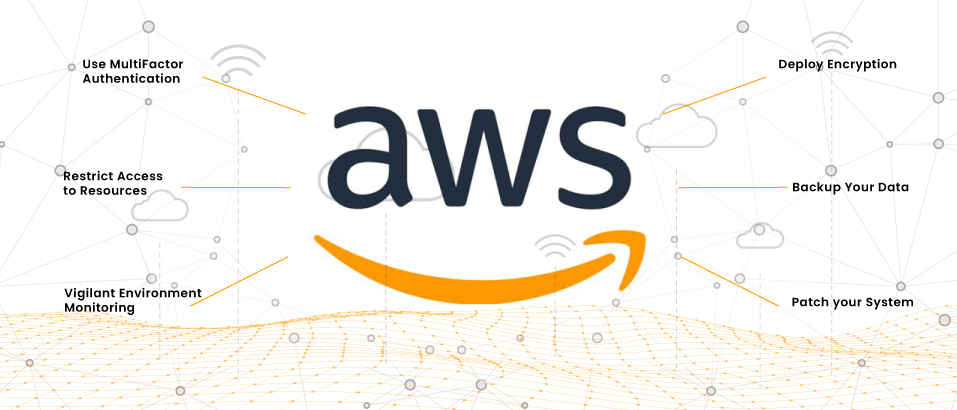In the contemporary business scenario, the use of cloud services has become imperative. The advent of cloud computing has transformed the operational landscape for businesses, offering notable advantages like enhanced flexibility, scalability, and cost-effectiveness. However, these benefits come with some risks, including data breaches and cyber-attacks. Therefore, it is essential to take AWS security best practices seriously to protect your cloud environment.
Catering to millions of clients across the globe, Amazon Web Services (AWS) is one of the most sought-after cloud service providers worldwide. AWS offers a wide range of security features to protect customers’ data and applications. The responsibility of configuring security features to safeguard the cloud environment lies with the customer.
In this blog post, we will explore the AWS security best practices that you should implement to secure your cloud environment.
AWS’s Best Practices to Secure your Cloud Environment:

- Use Multifactor Authentication:
Employing MFA fortifies your AWS account security by adding an additional layer of protection. MFA requires users to provide a second factor, such as a code generated by a smartphone app, in addition to their username and password to access AWS resources. MFA usage can shield your account against unapproved access, even in cases where your password is exposed to malicious actors. According to AWS, enabling MFA can prevent 99.9% of account compromises. - Restrict Access to Resources:
Restricting access to resources is an essential AWS security best practice. You should limit access to your AWS resources only to the users and services that require it. You can achieve this by creating IAM (Identity and Access Management) policies that grant only the necessary permissions. By using IAM policies, you can control who can access your AWS resources and what actions they can perform. - Vigilant Environment Monitoring:
Keeping a watchful eye on your environment is vital to promptly identify and address potential security breaches. AWS provides several tools to help you monitor your environment, such as AWS CloudTrail, AWS Config, and Amazon CloudWatch. AWS CloudTrail logs all AWS API calls, while AWS Config monitors and records all changes to your AWS resources. Amazon CloudWatch provides monitoring and logging services for your AWS resources. - Deploy Encryption:
Encryption entails transforming data into a protected format that only authorized parties can decipher using a decryption key. AWS provides several encryption options to protect your data, such as server-side encryption (SSE) and client-side encryption. Secure Data Storage: Server-side encryption safeguards your data while it’s at rest, while client-side encryption protects your data before transmission to AWS. Encryption shields your data from unauthorized access, guaranteeing its confidentiality. - Backup Your Data:
Regularly backing up your data is a critical security measure. AWS offers several backup and recovery services like Amazon S3 and Amazon Glacier, ensuring that your data remains retrievable in case of a disaster or security breach. By using these services, you can store your data in a secure and durable manner and recover it when needed. - Patch your System:
Patching your systems is a critical AWS security best practice. By regularly applying security patches, you can ensure that your systems are up to date with the latest security fixes. AWS provides patching services for EC2 instances, RDS databases, and other services. By using these services, you can automate the process of patching your systems and ensure that they are always secure. - Implement Network Security:
Implementing network security is essential to protect your AWS resources from network-based attacks. AWS provides several network security features, such as security groups, network access control lists (ACLs), and virtual private clouds (VPCs). By using these features, you can control the traffic to and from your AWS resources and ensure that your network is secure.
Click here to know more about the ways AWS is beneficial for your business.

Conclusion:
In conclusion, the adoption of cloud services has become a necessity for businesses, and AWS is one of the most popular cloud providers globally. However, with the significant benefits of cloud computing comes the risk of cyber-attacks and data breaches. It is essential to implement AWS security best practices to protect your cloud environment from unauthorized access, data theft, and other security incidents. By using MFA, restricting access to resources, monitoring your environment, implementing encryption, backing up your data, patching your systems, and implementing network security, you can ensure that your cloud environment is secure. As Gartner reports, most cloud security failures will be the customer’s fault, emphasizing the need for businesses to take responsibility for the configuration of their security settings. Implementing AWS security best practices is crucial to safeguard your business and its reputation, protect your sensitive data, and maintain customer trust.
